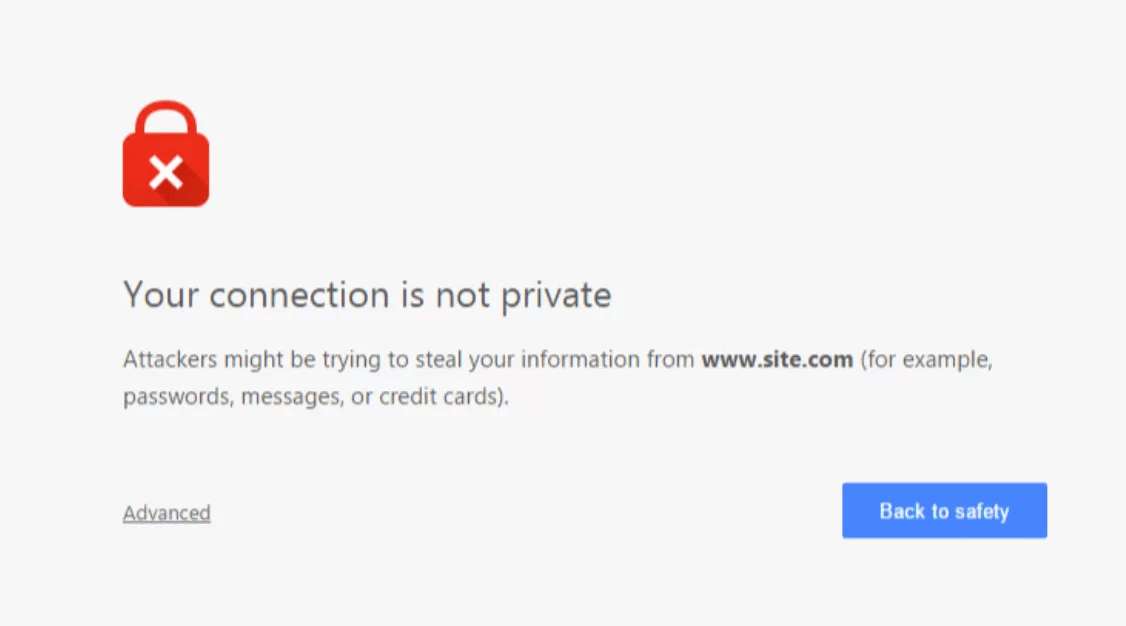
In today’s digital landscape, trust is everything. Consumers are more aware than ever of fraudulent websites and phishing scams. So if your website looks unprofessional, unfinished, and unsecure, chances are your visitor will leave for a competitor site. Thankfully though there are a number of features you can embed into your website that can help you instill trust in your visitors.
Here is a roundup of the seven most important ways that you can promote trust and convert your visitors.
1. Install an SSL Certificate
SSL Certificates, or HTTPS Secure Certificates, are displayed as the green padlock symbols in the top left-hand corner of a webpage, next to the URL address.
For any business, these are important. SSL Certificates means that a visitor’s data is handled safely and securely through an encrypted connection. This places extra trust in your website because it shows you have the correct security installed.
What could deter people more than seeing the below warning message when trying to visit your website?
If you’re an eCommerce merchant, this is even more important. Very few people will be willing to buy from your store if their financial data is not going to be secured. Websites without SSL Certificates are at higher risk of being compromised, after all.
All website hosting platforms and domain name registrars should offer the opportunity to buy or install an SSL Certificate. Depending on which provider you use, SSL price ranges anywhere from $35 a month, to $200 a year. It’s certainly an investment that will pay its dividends.
2. Display social proof
Social proof is a common tactic that helps visitors feel secure when visiting a brand new website. It stems from consumer psychology and suggests that our behavior is heavily influenced by others.
Online, social proof helps promote feelings of trust by showing new visitors that other people actively use the site and have good experiences. This displays that the brand and website are genuine, appeasing fears of being scammed or receiving a bad experience. Social proof can range from anything: From reviews or testimonials to significant Instagram followers or likes on Facebook.
For eCommerce websites, one of the most important types of reviews will be for your products. In a survey of 1,000 customers, it was found that having better reviews is the number one factor that drives people to choose a higher-priced option.
Upon clicking the review number the page scrolls down to see all 332 reviews.
This allows potential buyers to quickly access reviews and alleviate any concerns about product quality. A nice feature that AllBirds also highlights is the “size fit” highlight at the top.
A big issue for fashion retailers that can lead to a lot of returns is clothing that doesn’t fit. By clearly displaying this AllBirds is again reducing any barriers to purchase.
Any of these examples are capable of putting new visitors at ease and trusting in your business. Best of all, they’re free!
New stores can collect social proof such as reviews or testimonials by offering incentives for leaving one. And any size brand that already has a mass social following can display this prominently somewhere on their website.
3. Include trust badges
Trust badges are a quick and simple way to show users they are in good hands. You can place these strategically throughout your website to reassure customers they are safe to transact with you.
Examples of trust badges can be a secure checkout badge or showing any awards that your product has won. These all quickly instill trust in visitors.
Most commonly, trust badges are placed on the checkout page for this precise reason. Seeing trust badges helps visitors be assured that their checkout experience will be safe, and also that if anything goes wrong, there are ways to claim their money back.
4. Show your brand values with an About Us page
Your “About Us” page should not be overlooked.
The reason behind this is simple: None of us like dealing with faceless entities. Putting a voice, or a face, to a name helps make the experience much more personal and promotes trust by instigating the building of a relationship.
If we can see who we’re dealing with, we’re actively put at ease because we know that person is a real person. Likewise, we know if something goes wrong there is someone to hold accountable.
For eCommerce websites, it’s your chance to showcase your values. This can be in the form of detailing how you source products, support local charities, or just the story of how you got started.
Upon clicking into the “who we are” option you’re greeted with headings focusing on the key aspects behind ASOS’ brand. In the fashion industry ethical fashion is a growing trend, ASOS addresses this and clarifies its stance.
Vegan shoe brand Veja also has an incredibly detailed about us section, so much so that they have split it into specific chapters and even made an audio version of it. For shoppers who value trust and transparency in the brands they choose, Veja’s about us page is a leading example of how to showcase brand identity and values.
5. Make contact information easy to find
If a website does not have a contact us page this is a red flag in most customers’ minds. If things go wrong with a purchase buyers will want to know that any issues can be easily raised and resolved with you. By actively displaying ways that visitors can get in touch with you, either through the use of chatbots or a Contact Us page shows that you are available to help customers at any time.
Research has found that live chat is now the leading digital contact method for online customers. 46% of customers prefer live chat compared to just 29% for email, and 16% for social media. So ensuring you have a good level of digital customer engagement is vital.
This promotes trust because visitors know it is easy to reach you if they have a question or problem.
It’s also effective for potentially converting visitors. If for example, someone has a question, they can contact your business directly, receive their answer, and potentially use your company. Whereas without this, the visitor may have had to leave to a competitor site.
For eCommerce stores, one of the main reasons for basket abandonment is unforeseen delivery costs. So it’s important to have all this information quickly available to the user and ensure all return policies are clearly displayed.
6. Have a clean and modern website design
A clean and modern visitor experience is one of the most important things to instill trust.
Websites that look unfinished or overcomplicated won’t convert visitors to consumers because they look unprofessional.
This is the same for websites that are significantly outdated when compared to competitors. Static page websites that are missing most of the modern elements like HTML videos and CSS themes could give the impression that the business is no longer active.
Both of these things will send visitors running, so it’s important to invest time and money in installing a clean and modern design. These don’t need to be huge expenses either: Website hosting platforms like WordPress or Wix offer free website creation and hosting, and contain a plethora of modern designs.
7. Personalize the online user experience
Finally, one of the most growing areas of interest for marketers is the personalizing of their website experiences. Personalization has been shown to increase engagement and conversions. This is because it actively instills trust.
By either personalizing product recommendations or greeting a customer on their return to the website, it shows that the brand is investing in that customer as a person. This plays into the Meet the Team feelings earlier in building a relationship.
Yieldify surveyed 400 eCommerce leaders across the US and UK and found that personalization across all channels is present. Website personalization leads the pack, ahead of channels such as SMS (42% personalization adoption) and mobile apps (56% personalization adoption).
Personalization aspects need a sophisticated CRM and good data analytics to work correctly, so if you’re a new business owner this could be something to keep in mind much further down the line.
However, for already established websites this could set you apart from competitors who are missing that personal touch.
In Conclusion:
Instilling trust in your visitors is the only way to convert them into valued customers. Adding trust to your website doesn’t even need to come at an expense: There are a whole host of free options available to you, including social proof and website design.








